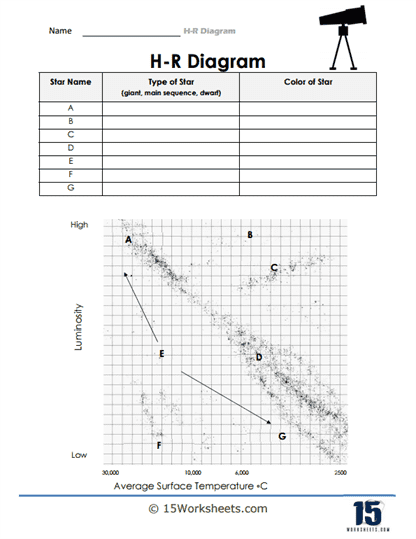Types and Colors of Stars

Worksheet Description
Seven distinct stars, labeled A through G, are plotted on the diagram, and students are tasked with deducing each star’s type and color based on its position. By referring to the chart’s axes, which signify the star’s average surface temperature and its luminosity, students must classify each star as a giant, main sequence, or dwarf and determine its color. This visual and interactive approach is aimed at fostering a deeper understanding of the relationship between a star’s temperature, brightness, and classification.
To effectively tackle this worksheet, students should first familiarize themselves with the H-R Diagram, noting the progression of average surface temperature along the x-axis and the range of luminosity on the y-axis. Observing the plotted stars, A through G, students can then discern their respective positions, drawing conclusions on their potential classification and color. Cross-referencing these positions with common knowledge of star types — for instance, main sequence stars forming a distinct band or the location of red giants — will aid in accurately filling out the table. Each star’s placement will hint at its type and color, allowing students to make educated deductions.
The core objective of this worksheet is to instill in students the ability to analyze and interpret the H-R Diagram, recognizing the significance of a star’s position on this chart. Through this hands-on exercise, learners are introduced to the vast diversity of stars in the cosmos, understanding their varying temperatures, luminosities, and classifications. The worksheet emphasizes the interconnectedness of these stellar attributes, prompting students to deduce one from another. Ultimately, students will emerge with a holistic grasp of how astronomers employ the H-R Diagram as a roadmap to the stars, categorizing these celestial bodies based on distinct characteristics.
